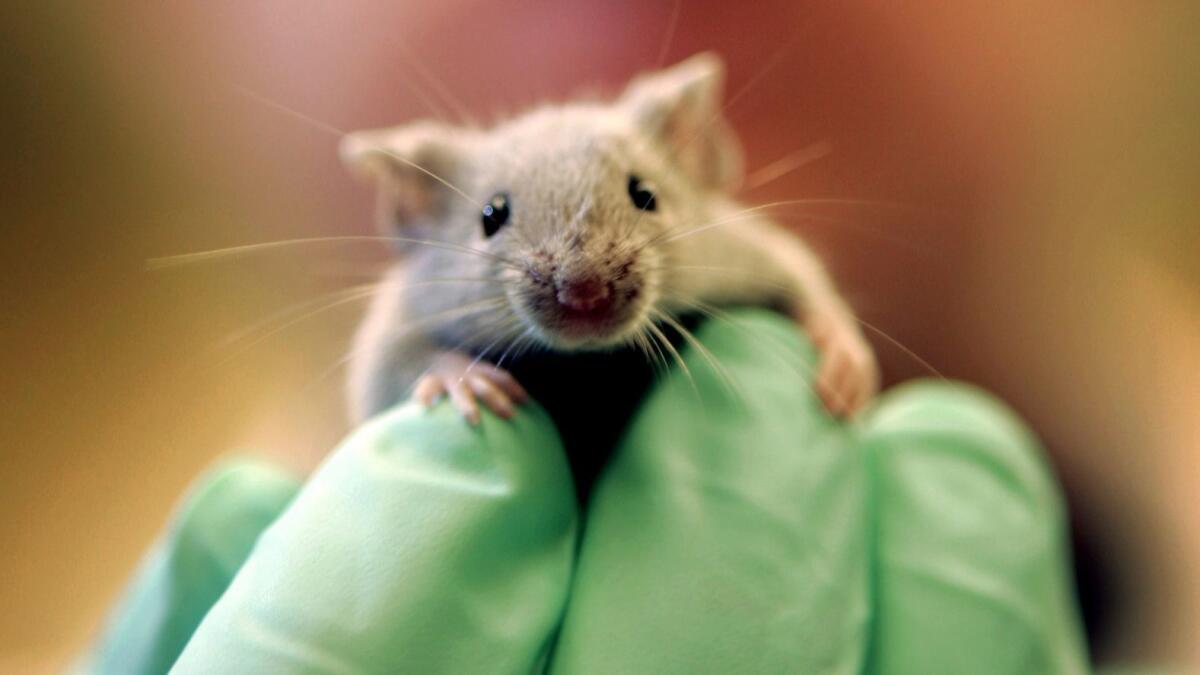Researchers avoid ‘messy’ hormonal female mice. And that hurts women

Is sexism getting in the way of good science?
An essay published in Thursday’s edition of the journal Science argues that the stereotypes that have plagued women since at least the 1800s — that they are emotional creatures who are more prone to hormone-fueled mood swings than men — have also affected decades of neuroscience research involving mice and other animals.
Until recently, most neuroscience labs have conducted their experiments on males only, said essay author Rebecca Shansky, a neuroscientist at Northeastern University in Boston. Scientists justified this exclusion by claiming that fluctuating hormone levels in females had the potential to make test results “messy.”
This was true even for research involving disorders that are more likely to affect women, like depression and PTSD.
“I came to realize that we are viewing female rodents as research subjects through the same lens that we talk about women in society,” Shansky said. “That is problematic if we are supposed to be objective scientists.”
The issue isn’t merely theoretical, she added. It has led to tangible consequences for women’s health. (More on that in a bit.)
Leaders of the National Institutes of Health agree. In 2015, the NIH, which spends more money on medical research than any other entity in the world, issued a mandate requiring scientists to conduct their experiments on both male and female animals in order to qualify for funding grants as of 2016.
The policy change prompted moaning and groaning at conferences and on social media from researchers who had never worked with female mice before. They publicly agonized over how to design experiments that would account for the variability of ovarian hormones and worried about the logistics of tracking the estrous cycle in female mice (not to mention the expense of adding a second cohort to their studies).
Some even wondered if it would be simplest to remove their ovaries altogether.
The bellyaching inspired Shansky to write the essay.
“The more I heard people talk about it, the more riled up I got,” she said.
What especially got under her skin was the underlying assumption that a rigorous study of the female mouse brain required all kinds of manipulations to compensate for female hormones — and that this was not the case with males.
“It felt like a double standard,” she said. “And I could see very quickly that this paralleled the way we think about women’s dispositions compared to men’s in humans.”
It is well documented that ovarian hormones in female mice fluctuate over the course of a four- to five-day cycle. However, studies have also shown that male mice have hormonal disparities as well.
For instance, scientists have known since the 1970s that when male mice are housed in groups, they form a hierarchical structure. Dominant males can have up to five times more testosterone circulating in their systems than subordinate mice, Shansky said.
And indeed, most mice used in lab experiments are housed in groups.
“Both testosterone and estrogen are powerful neuromodulators,” Shansky wrote in the Science essay. If variations in estrogen levels in female mice can muddy the results of a study, surely it follows that variations in testosterone in male mice would do the same.
But that’s not how researchers have traditionally seen it.
“When male animals make up the majority of experimental subjects, basic scientists mostly considered hormonal variability a non-issue,” Shansky wrote.
Other neuroscientists confirmed that in the past, most researchers in the field relied on male rodents for their studies and that many are afraid of the complicating factor of female hormones.
“Since the 1960s, using male mice was absolutely the default unless you were studying reproduction,” said Margaret McCarthy, a neuroscientist at the University of Maryland School of Medicine.
She pointed to a 2010 study in Neuroscience Biobehavior Review that found that studies of male animals outnumbered those of females by a factor or 5.5 to 1. That study also reported that male bias in animal studies had increased over the last half century.
McCarthy spent the last 25 years advocating for the inclusion of female animals in scientific studies. Ironically, she thinks the roots of the disparity can be traced in part to the 1960s and ’70s, when the notion of equality between the sexes began to gain ground.
“There was this idea that men and women are the same and women can do everything a man can do,” she said.
Back then, a male neuroscientist who went looking for differences between a female brain and a male brain would likely have been skewered by his peers, she said.
Later, research showed that hormones can affect cognitive parts of the brain, McCarthy said. That convinced some scientists that if hormones were the variable separating male and female brains, they could easily eliminate that variable by running their experiments exclusively on males.
“It seemed like sound experimental design,” she said.
But it wasn’t. As scientists would later discover, male and female brains do not function exactly the same, either in rodents or in humans.
The failure to run preclinical experiments on both male and female animals means that in many cases, differences in the ways a new drug might affect the female brain weren’t detected until it was too late.
In fact, the practice of excluding female animals from basic research has resulted in medicines with a higher rate of adverse side effects in women, scientists said.
“It starts right from the beginning,” said Gül Dölen, a neuroscientist at the Johns Hopkins School of Medicine. “If we don’t do the experiments in female mice, then you are just providing more fodder for leaving out women in clinical trials, or treating them like they are just defective males.”
Whether or not the NIH’s policy shift will lead to significant change remains to be seen, McCarthy said.
“We are still in the middle of experiment,” she said. “We have a whole lot of people with grants that were funded in the last two to three years who said they are going to look at males and females. We’ll have to wait and see if they actually did it.”
In the meantime, Shansky said she will continue urging her colleagues to reconsider their belief that it’s much more complicated to study females than males.
“We have to change the narrative,” she said. “An experiment done in a female animal is just as valid and normal and informative as those that are done in males.”
Do you love science? I do! Follow me @DeborahNetburn and “like” Los Angeles Times Science & Health on Facebook.







